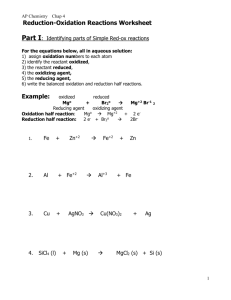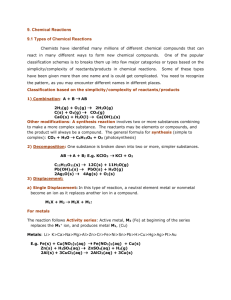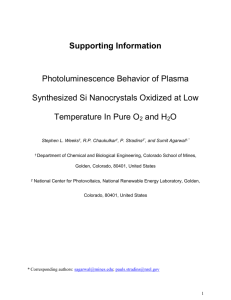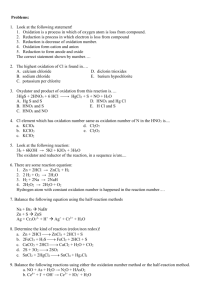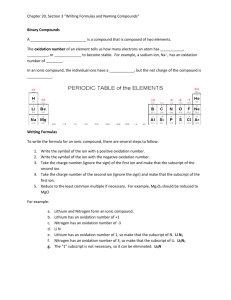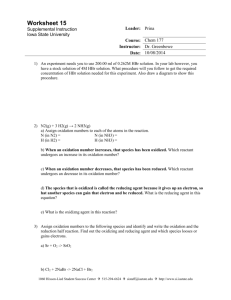Reactions Notes 1. Chemical Reactions A. Evidence of Chemical
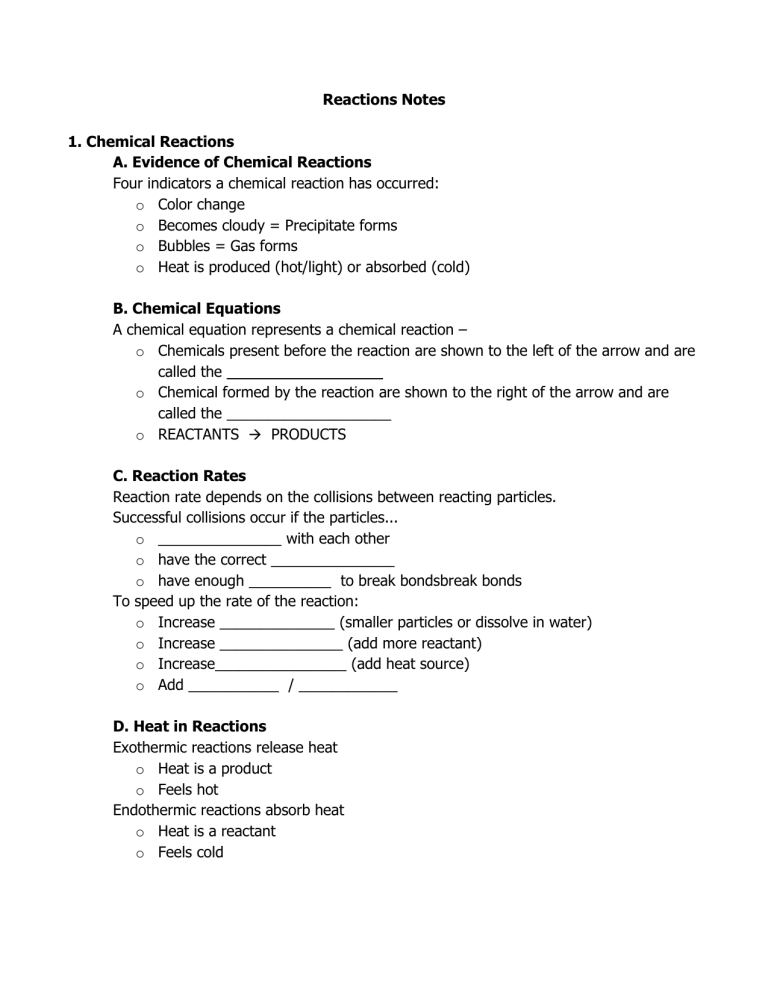
Reactions Notes
1. Chemical Reactions
A. Evidence of Chemical Reactions
Four indicators a chemical reaction has occurred: o Color change o Becomes cloudy = Precipitate forms o Bubbles = Gas forms o Heat is produced (hot/light) or absorbed (cold)
B. Chemical Equations
A chemical equation represents a chemical reaction – o Chemicals present before the reaction are shown to the left of the arrow and are called the ___________________ o Chemical formed by the reaction are shown to the right of the arrow and are called the ____________________ o REACTANTS PRODUCTS
C. Reaction Rates
Reaction rate depends on the collisions between reacting particles.
Successful collisions occur if the particles... o _______________ with each other o have the correct _______________ o have enough __________ to break bondsbreak bonds
To speed up the rate of the reaction: o Increase ______________ (smaller particles or dissolve in water) o Increase _______________ (add more reactant) o Increase________________ (add heat source) o Add ___________ / ____________
D. Heat in Reactions
Exothermic reactions release heat o Heat is a product o Feels hot
Endothermic reactions absorb heat o Heat is a reactant o Feels cold
2. Types of Reactions
Double Displacement:
Single Displacement:
Decomposition:
Synthesis:
Combustion:
Double Displacement reactions
Precipitation Reaction: Double Displacement reactions where the driving force is formation of a solid.
Acid-Base/ Neutralization Reaction: Double Displacement reactions where the driving force is formation of a liquid. (water)
Oxidation Reduction reactions: (redox)
Driving Force = Transfer of electron
Always in single displacement reactions
Sometimes in Synthesis and Decomposition
Never in Double Displacement
Learning Check - Classify the following reactions.
2 KNO
3
2 KNO
2
+ O
2
2 C
2
H
2
+ 5 O
2
4 CO
2
+ 2 H
2
O
CaO + H
2
SO
4
CaSO
4
+ H
2
O
3 CaCl
2
+ 2 Na
3
PO
4
Ca
3
(PO
4
)
2(s)
+ 6 NaCl
2 Fe + 6 HC
2
H
3
O
2
2 Fe(C
2
H
3
O
2
)
3
+ 3 H
2
2 KCl + 3 O
2
2 KClO
3
3. Balancing Chemical Equations o The reactants and the products contain the same atoms, but the chemical reaction has changed the way they are grouped. o In a chemical reaction, atoms are neither created nor destroyed, all atoms present in the reactants must be present in some form in the products. o Balancing an equation makes sure that there is the same number and type of atom on both sides of the equation. o The chemical equation for a reaction provides us with three important pieces of information:
o States of matter are shown with the following symbols:
(s) solid (l) liquid (g) gas (aq) aqueous, dissolved in water
o HINTS :
– Don’t forget the diatomics – BrINClHOF if they appear by themselves they must be written as: Br
2
, I
2
, N
2
, Cl
2
, H
2
, O
2
, F
2
,
– Balance oxygen and hydrogen last.
– If you have a split element, make the odd number even
– If you have a polyatomic ion that does not change, balance it as the ion
Examples –
1.
Liquid ethanol, C
2
H
5
OH, reacts with oxygen gas to produce carbon dioxide gas and water vapor.
2.
Solid potassium reacts with liquid water to form hydrogen gas and potassium hydroxide that dissolves in water.
Examples:
1) C
3
H
8(g)
+ O
2(g)
CO
2(g)
+ H
2
O
(g)
2) NH
4
NO
2(s)
N
2(g)
+ H
2
O
(g)
3) NO
(g)
N
2
O
(g)
+ NO
2(g)
Learning Check – Balance the equations
HNO
3(aq)
NO
2(g)
+ H
2
O
(l)
+ O
2(g)
Mg
(s)
+ H
2
O
(l)
Mg(OH)
2(s)
+ H
2(g)
4. States of Substances o Soluble solid – readily dissolves in water o Insoluble and slightly soluble solid – a solid where such a tiny amount dissolves in water that it is undetectable to the naked eye o Solubility is temperature dependent o Solubility Rules (on snoopy sheet) o Ex. Predict whether the following substances are soluble or insoluble.
AgNO
3
Al(OH)
3
ZnSO
4
Li
2
CO
3
Cu
3
PO
4
Learning Check - Determine if the following are AQUEOUS or SOLID lead (II) nitrate potassium sulfide barium hydroxide ammonium carbonate o When a soluble ionic salt dissolves in water the ions separate and a hydration shell is formed around each ion (Dissociation) o Examples –
Ba(NO
3
)
2
in water –
Aluminum carbonate in water – o Draw a beaker of dissociated sodium chloride; a beaker of dissociated Aluminum nitrate; and a beaker of silver chloride. o Special Solubility Rules
Acids are aqueous
Most metal oxides are solids
Most non-metal oxides are gases
Learning Check - Determine the state: lead(II) phosphate magnesium oxide nickel dinitrogen monoxide chlorine sulfuric acid sodium sulfide
5. Predicting Whether a Reaction Will Occur
Four Driving Forces
Formation of a solid (precipitate)
Formation of water
Transfer of electrons
Formation of a gas
If a driving force occurs the reaction will take place.
6. Predicting Products
Steps for Predicting Products
Formulas for reactants
Type of Reaction
Predict Product formulas (using ions)
States (using solubility rules)
Balance Equation or NO REACTION (if missing driving force)
A. Double Displacement Reactions: two compounds combine to produce two different compounds - Acid-Base and Precipitation Reactions.
Use solubility rules.
General Equation:
Example: Lead (II) acetate + sodium chloride
B. Single Replacement Reactions: Activity Series
Single Displacement reactions: an element and a compound combine to form a new element and compound.
Use the activity series.
General Equation:
Example: sodium + lead (II) acetate
Activity Series
Active metal elements can replace less active metals, active nonmetal elements can replace less active nonmetals.
Use the Activity series (snoopy sheet) to determine whether or not the reaction will occur.
Driving force is the transfer of electrons.
Learning Check – Predict the products and balance the equation
1.
___ I
2
+ ___ NaCl
2. ___ H
2
SO
4
+ ___ NaOH
7. Oxidation vs. Reduction o Rules for Oxidation Numbers
The oxidation number of any uncombined element is 0.
The oxidation number of a monatomic ion equals the charge on the ion.
The more-electronegative element in a binary compound is assigned the number equal to the charge it would have if it were an ion.
The oxidation number of fluorine in a compound is always -1.
Oxygen has an oxidation number of -2 unless it is combined with F (when it is
+2), or it is in a peroxide (such as H
2
O
2
or Na
2
O
2
), when it is -1.
The oxidation state of hydrogen in most of its compounds is +1 unless it is combined with a metal, in which case it is -1. o The sum of the oxidation states in a neutral compound must equal zero and must be equal to the overall charge in an ionic compound. o Remember LEO GER: LOSE ELECTRONS OXIDATION
GAIN ELECTRONS REDUCTION o Something that is reduced is called an oxidizing agent. o Something that is oxidized is called a reducing agent. o For each reaction, identify the atoms that undergo reduction, or oxidation.
2 H
2 (g)
+ O
2 (g)
2 H
2
O
(g)
Zn
(s)
+ Cu 2+
(aq)
Zn 2+
(aq)
+ Cu
(s)
2 AgCl
(s)
+ H
2 (g)
2 H +
(aq)
+ 2 Ag
(s)
+ 2 Cl -
(aq)
2 MnO
4
-
(aq)
+ 16 H +
(aq)
+ 5 C
2
O
4
2-
(aq)
2 Mn 2+
(aq)
+ 10 CO
2(g)
+ 8H
2
O
(l)
Learning Check
Assign oxidation states to each of the atoms in the following compounds: a. SO
2 b. S c. SO
3
Assign oxidation states to each atom in the equation. Determine which element was oxidized and which was reduced.
2 Al + 3 CuCl
2
2 AlCl
3
+ 3 Cu



